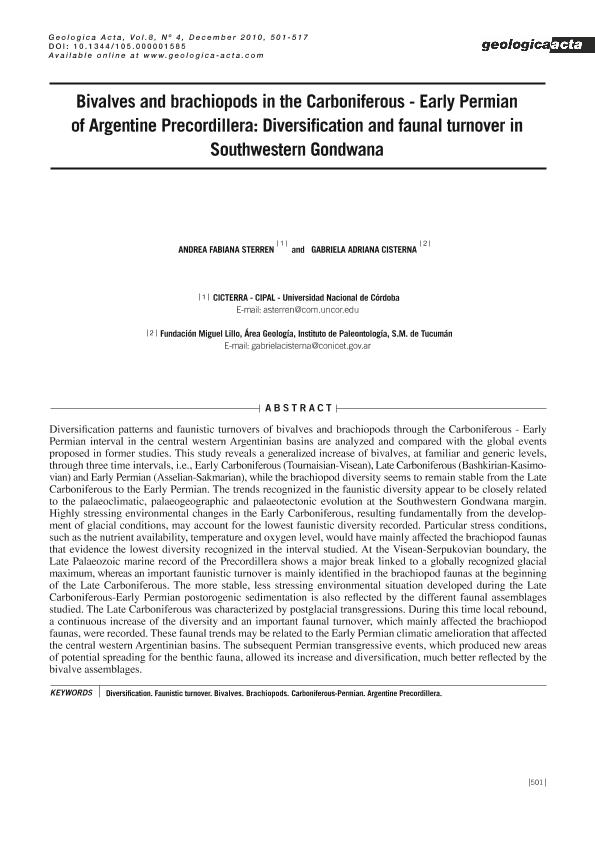Mostrar el registro sencillo del ítem
dc.contributor.author
Sterren, Andrea Fabiana

dc.contributor.author
Cisterna, Gabriela Adriana

dc.date.available
2018-08-03T20:48:35Z
dc.date.issued
2010-12
dc.identifier.citation
Sterren, Andrea Fabiana; Cisterna, Gabriela Adriana; Bivalves and brachiopods in the Carboniferous - Early Permian of Argentine Precordillera: Diversification and faunal turnover in Southwestern Gondwana; Universidad de Barcelona; Geologica Acta; 8; 4; 12-2010; 501-517
dc.identifier.issn
1695-6133
dc.identifier.uri
http://hdl.handle.net/11336/54179
dc.description.abstract
Diversification patterns and faunistic turnovers of bivalves and brachiopods through the Carboniferous - Early Permian interval in the central western Argentinian basins are analyzed and compared with the global events proposed in former studies. This study reveals a generalized increase of bivalves, at familiar and generic levels, through three time intervals, i.e., Early carboniferous (Tournaisian-Visean), Late Carboniferous (Bashkirian-Kasimovian) and Early Permian (Asselian-Sakmarian), while the brachiopod diversity seems to remain stable from the Late Carboniferous to the Early Permian. The trends recognized in the faunistic diversity appear to be closely related to the palaeoclimatic, palaeogeographic and palaeotectonic evolution at the Southwestern Gondwana margin. Highly stressing environmental changes in the Early Carboniferous, resulting fundamentally from the development of glacial conditions, may account for the lowest faunistic diversity recorded. Particular stress conditions, such as the nutrient availability, temperature and oxygen level, would have mainly affected the brachiopod faunas that evidence the lowest diversity recognized in the interval studied. At the Visean-Serpukovian boundary, the Late Palaeozoic marine record of the Precordillera shows a major break linked to a globally recognized glacial maximum, whereas an important faunistic turnover is mainly identified in the brachiopod faunas at the beginning of the Late Carboniferous. The more stable, less stressing environmental situation developed during the Late Carboniferous-Early Permian postorogenic sedimentation is also reflected by the different faunal assemblages studied. The Late Carboniferous was characterized by postglacial transgressions. During this time local rebound, a continuous increase of the diversity and an important faunal turnover, which mainly affected the brachiopod faunas, were recorded. These faunal trends may be related to the Early Permian climatic amelioration that affected the central western Argentinian basins. The subsequent Permian transgressive events, which produced new areas of potential spreading for the benthic fauna, allowed its increase and diversification, much better reflected by the bivalve assemblages.
dc.format
application/pdf
dc.language.iso
eng
dc.publisher
Universidad de Barcelona

dc.rights
info:eu-repo/semantics/openAccess
dc.rights.uri
https://creativecommons.org/licenses/by-sa/2.5/ar/
dc.subject
Argentine Precordillera
dc.subject
Bivalves
dc.subject
Brachiopods
dc.subject
Carboniferous-Permian
dc.subject
Diversification
dc.subject
Faunistic Turnover
dc.subject.classification
Meteorología y Ciencias Atmosféricas

dc.subject.classification
Ciencias de la Tierra y relacionadas con el Medio Ambiente

dc.subject.classification
CIENCIAS NATURALES Y EXACTAS

dc.title
Bivalves and brachiopods in the Carboniferous - Early Permian of Argentine Precordillera: Diversification and faunal turnover in Southwestern Gondwana
dc.type
info:eu-repo/semantics/article
dc.type
info:ar-repo/semantics/artículo
dc.type
info:eu-repo/semantics/publishedVersion
dc.date.updated
2018-08-02T14:51:32Z
dc.identifier.eissn
1696-5728
dc.journal.volume
8
dc.journal.number
4
dc.journal.pagination
501-517
dc.journal.pais
España

dc.journal.ciudad
Barcelona
dc.description.fil
Fil: Sterren, Andrea Fabiana. Consejo Nacional de Investigaciones Científicas y Técnicas. Centro Científico Tecnológico Conicet - Córdoba. Centro de Investigaciones en Ciencias de la Tierra. Universidad Nacional de Córdoba. Facultad de Ciencias Exactas Físicas y Naturales. Centro de Investigaciones en Ciencias de la Tierra; Argentina. Universidad Nacional de Córdoba. Facultad de Ciencias Exactas Físicas y Naturales. Centro de Investigaciones Paleobiológicas; Argentina
dc.description.fil
Fil: Cisterna, Gabriela Adriana. Consejo Nacional de Investigaciones Científicas y Técnicas; Argentina. Fundación Miguel Lillo; Argentina
dc.journal.title
Geologica Acta

dc.relation.alternativeid
info:eu-repo/semantics/altIdentifier/url/http://www.redalyc.org/articulo.oa?id=50515686010
dc.relation.alternativeid
info:eu-repo/semantics/altIdentifier/doi/http://dx.doi.org/10.1344/105.000001585
dc.relation.alternativeid
info:eu-repo/semantics/altIdentifier/url/http://revistes.ub.edu/index.php/GEOACTA/article/view/105.000001585
Archivos asociados
